49 Search Results for generalization
July 11, 2016
by Carole Zangari -
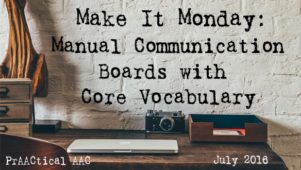
Welcome to Make It Monday, a series in which we hope to inspire your team to create communication boards and instructional materials for students who need or already use core vocabulary. In the first post, Getting Ready for a Core Vocabulary Journey, we talked about getting set up to make materials for expressive and receptive language use. Today, we get into making manual communication boards (MCBs). About Manual Communication Boards The term manual communication board refers to a ‘no-tech’ AAC support that students can use to express themselves. Typically printed on paper and laminated, most MCBs have grids of words organized by part of speech (e.g., verbs in one area, adjectives in another). MCBs that are designed for use in a particular activity, such as doing an art project or participating in Circle Time, are called activity-based communication displays, or ABCDs. ABCDs were very popular in the early days of... [Read More...]
July 7, 2016
by Carole Zangari -
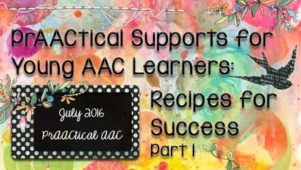
One of the most gratifying things about the AAC field is being able to connect with talented professionals who love what they do and are passionate about supporting learners with little or no functional speech. I am humbled by the incredibly generous ways in which clinicians are supporting their clients and one another. Today’s post, by SLP Sara Barnhill, is a case in point. Sara has worked at Children’s Hospital of Richmond at VCU (CHoR) for seven years. She is a member of the Assistive Technology (AT) Core team and completes multiple AAC evaluations per week as well as AAC therapy. Her caseload includes patients in clinics, out-patient therapy, and on the Transitional Care Unit which provides pediatric long-term care. Through her specialty areas, Sara has discovered a love for sharing information and training others. Sara has presented in multiple conferences at the local, state, and national levels. Sara has... [Read More...]
June 20, 2016
by Carole Zangari -
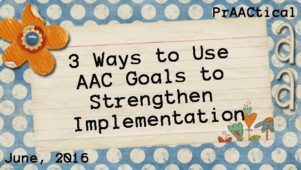
Concerned about AAC systems not being implemented as often as they should? Looking for ways to help AAC learners gain additional practice? Trying to help colleagues build the habit of actively supporting AAC learners? You are not alone. There are several strategies to boost the use of AAC, and adding some key phrases to the goals we write is one of them. Here are some thoughts on ways to use goals to strengthen the day-to-day AAC experiences of the learners with whom we work. Aided Language Input: Experienced AAC professionals and knowledgeable families understand that consistent use of this strategy is the most powerful way to build AAC use. If this is an issue for your AAC teams, consider adding verbiage to the goals that mandate the use of this strategy. Examples: “Given consistent AAC modeling, ___ will…” “When provided with aided language input, ___ will…” Frequent Implementation: Like many... [Read More...]
March 14, 2016
by Carole Zangari -
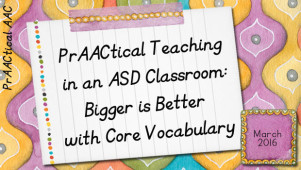
Today we launch a new series, PrAACtical Teaching in an ASD Classroom, which will address the nuts and bolts of infusing AAC throughout the school day. I couldn’t be more delighted to introduce you to two talented special educators, Amy Devin and Lauren Pawlowski, who work in the public school system in Michigan. Amy and Lauren began teaching in self‐contained ASD elementary classrooms in 2009 and taught in resource rooms prior to that. When they first started with their own classrooms, there was not much talk about core language, let alone how to implement it on a classroom-wide basis. They started with a 32-cell core board on a digitized speech device and now use a 64-location core vocabulary on a manual communication board, large instructional core boards, and individual AAC devices. They are passionate literacy teachers and believe that every child can read, write and communicate. Enjoy their post and... [Read More...]
February 22, 2016
by Carole Zangari -

Today, we welcome back an old friend, Lauren Enders. Many of you are already familiar with Lauren through the posts she has shared on AAC in the IEP, encouraging AAC implementation, and writing AAC goals, and also the wonderful work she does in curating resources on Pinterest. We’re thrilled that she will be joining us each month to highlight a different Pinterest board that has AAC-related content. Lauren identifies interesting and helpful resources and adds relevant commentaries to all of the items she includes. In this first post, she shares a collection of resources on apps that can be used to engage AAC learners in therapy, instruction, play, and leisure time. ::::::::::::::::::::::::::::::::::::::::::::::::::::::::::::::::::::: For the past few years, I have been building a Pinterest site with the goal of providing visual, categorized, and easily accessible resources that relate to AAC as well as Assistive Technology, Speech and Language Therapy, Special Education, iPads,... [Read More...]
November 24, 2015
by Carole Zangari -
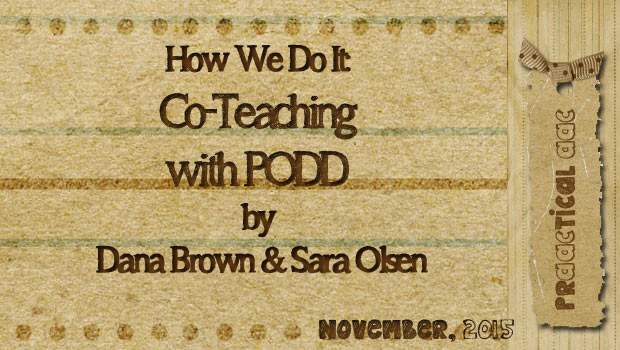
When SLPs and teachers work together for the benefit of students with little or no functional speech, the results can be magical. Today, we travel to Wisconsin to visit with SLP Dana Brown and Special Educator Sara Olsen who work together at the elementary school level. In this post, Dana and Sara tell us about their experiences using PODD in a classroom of students with intellectual disability. You can learn more about their work on YouTube (Watch Your Language) where they post Word of the Week videos and snippets of AAC use in different clasroom activities. Regular readers know that we’ve posted a few articles and videos on PODD. ::::::::::::::::::::::::::::::::::::::::: We write as a team of special educators, a Speech Language Pathologist (SLP) and an Intellectual Disabilities teacher, and one thing that we’ve learned working closely together is that AAC is difficult and ongoing. In this post, we are excited to share... [Read More...]
October 22, 2015
by Carole Zangari -
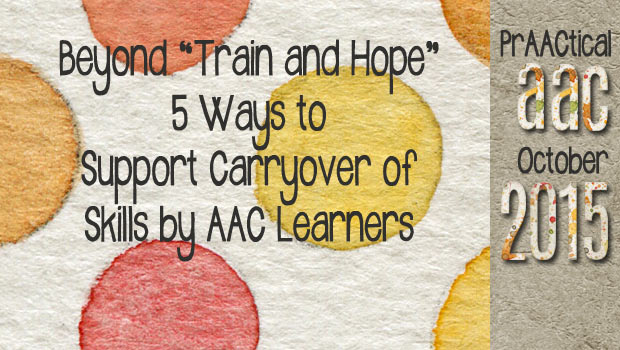
With her SLP, Marissa conjugates verbs and includes function words to make the sentence grammatically correct (e.g., “She is going home with me”). With others, she tends to use her AAC more telegraphically (e.g., “She go home me”). In therapy, Marcus uses his AAC to create 3-4 word sentences. In the classroom, he communicates mostly in single word utterances. Sound familiar? Marcus and Marissa have both learned skills in therapy sessions that they are not using in their daily lives. Data from their therapy sessions show that these students have mastered the target language skills, so the SLP is understandably disappointed when they revert back to using less sophisticated utterances in the classroom. Problems with carryover and skill generalization are not unique to AAC. Ask any SLP who does articulation therapy or teaches kids who stutter how to speak more fluently. Getting them to use the skills demonstrated in... [Read More...]
December 9, 2014
by Carole Zangari -
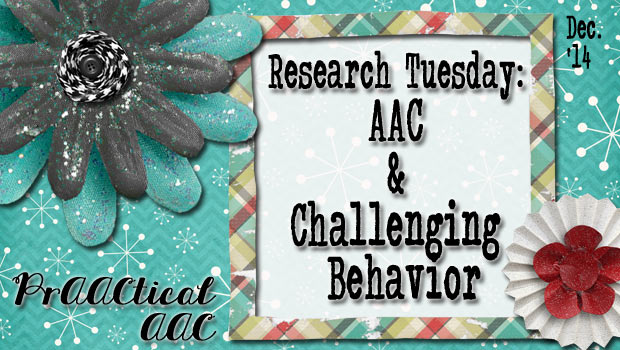
Research reviews are helpful tools for SLPs looking to implement evidence-based practices in their clinical work. In this month’s Research Tuesday post, we look at the work of Drs. Virginia Walker and Martha Snell, who conducted a meta-analysis to look at the relationship between challenging behaviors and AAC interventions. They looked at 54 different research studies with a total of 111 children and adults with AAC needs. They conducted both analytical and descriptive analyses. The research studies included participants at the emerging, prelinguistic, and multi-word levels of communication. Challenging behaviors were codes as distracting, disruptive, and/or destructive. Effect sizes were calculated using the Non-overlap of All Pairs method. Among their findings: AAC interventions reduce challenging behavior across a wide range of participants, including children and adults with a variety of developmental disabilities. AAC interventions were more effective with children (12 and under) than they were with adults (18 years and... [Read More...]
October 14, 2014
by Carole Zangari -
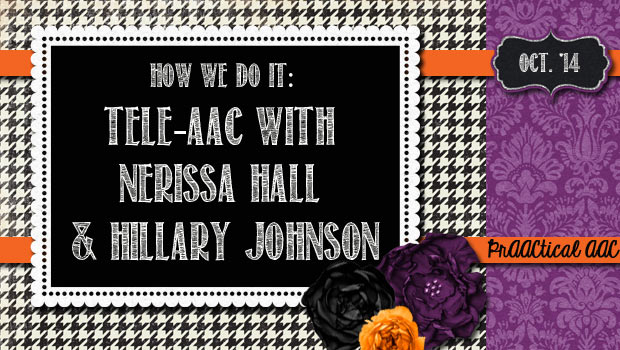
Have you been hearing a lot about telepractice lately and are wondering how that works when the client has AAC needs? In this post, we turn to Nerissa Hall and Hillary Jellison of Communicare who tell us how they use it in their clinical practice. Nerissa and Hillary are both SLPs and assistive technology practitioners specializing in AAC, AT, and telepractice/tele-AAC. They have worked together for a number of years and are the proud owners of Commūnicāre, LLC, organization based in Western Mass and CT, that offers intervention, consultation, and evaluation services focusing on supporting an individuals, or a team’s, success and independence through implementation of AAC, AT and innovative and evidence-based practices. We are committed to our clinical work, as well as translational research and are members of the C.A.R.E. Consortium. Tele-AAC: A Powerful Way of Supporting Individuals Using AAC Telepractice, which is used to provide professional services by linking clinicians... [Read More...]
July 10, 2014
by Carole Zangari -
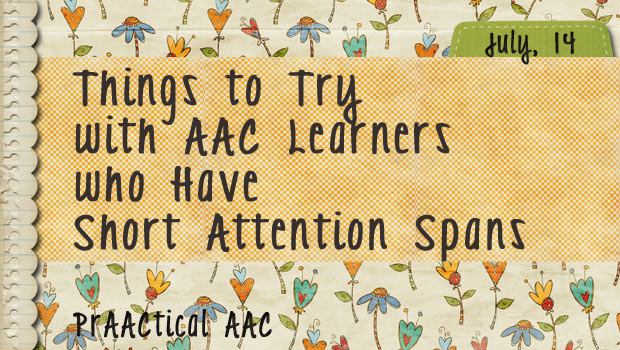
We love talking to AAC practitioners, hearing their stories, and picking up some tips along the way. Some conversations we love for the creative ideas or underlying passion. Others are memorable for less positive reasons. But still, they give us pause and challenge us to be better problem-solvers. “I love those ideas, but they won’t work with MY client: He doesn’t pay attention. He’s just not ready for all this. How do you expect me to teach someone with such a short attention span?” Glad you asked! First, don’t blame the learner. Like having short legs or frizzy hair, attention span is something over which some learners have little or no control. Their physiology is their physiology and they may not like it any more than we do. Use high-interest components in your therapy. The goals are the goals, but we can use things the client likes to make working on... [Read More...]









